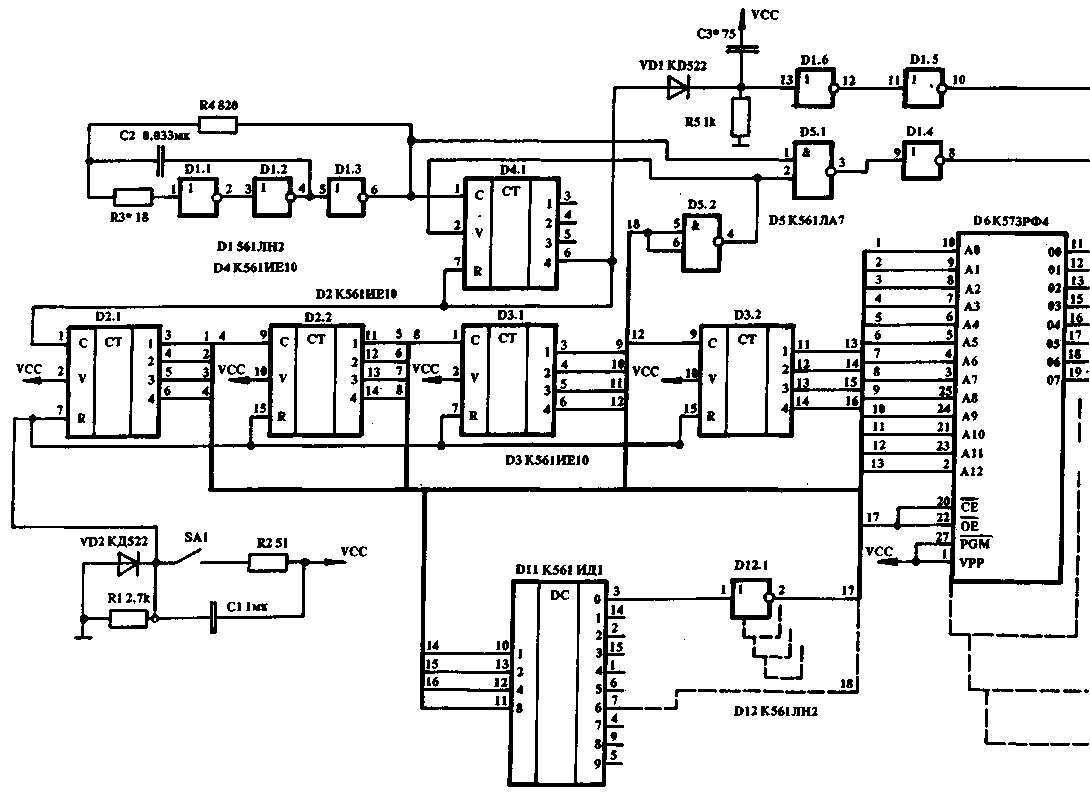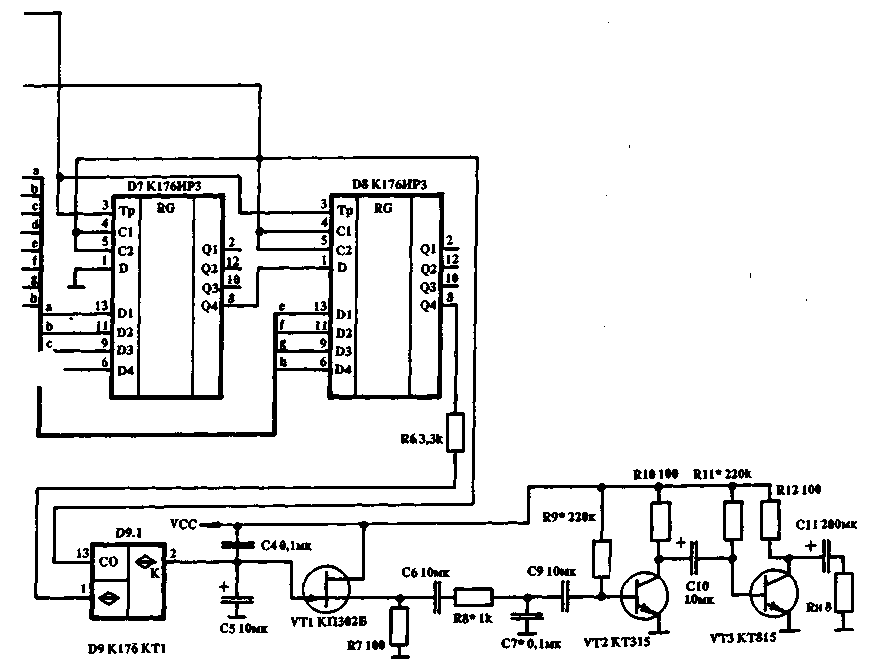speech synthesizer. Encyclopedia of radio electronics and electrical engineering

Encyclopedia of radio electronics and electrical engineering / Digital technology
 Comments on the article
Comments on the article
The speaking device (speech synthesizer) is used to reproduce human speech in various electronic and household devices (telephone answering machines, door locks, various toys). In the proposed device, in contrast to the known ones, a new method of signal generation is applied.
The device consists of a clock pulse generator, the output of which is connected to the input of the address generation device and the input of the control unit. The outputs of the address generator form an address bus. They are connected to the address inputs of the ROM, the outputs of which, forming a data bus, are connected to the data inputs of the parallel-to-serial converter. The output of the control unit is connected to the control input of the code conversion device. The output of the latter is connected to an output signal level shaping device, at the output of which a filter, an amplifier and a loudspeaker (reproducing device) are connected in series.
The device works as follows. After switching on, all counters included in the device are reset to zero. The address generator generates address zero on the address bus. At the signal of the control unit, the contents of the zero cell of the ROM are rewritten to the code conversion device. Information about the value of the eighth bit is sent to the level forming device. The pulses of the clock generator through the control unit act on the code converter, the output of which receives the 7th, 6th, etc., respectively. bits of the null byte. The level shaper generates an output signal in accordance with a given program. Upon receipt of eight pulses, the information stored in the zero cell of the ROM will be exhausted. The ninth pulse generates a new address and a signal for writing the output ROM code to the code conversion device from the control unit. Further, the whole process is repeated cyclically until all the information stored in the ROM is processed. The filter at the output of the conditioning device smoothes the signal by removing the high frequency components generated by the stepwise conditioning of the signal, the amplifier amplifies, and the loudspeaker reproduces the signal.
The schematic diagram of the device is shown in the figure.

(click to enlarge)

(click to enlarge)
The clock pulse generator is assembled on three inverters of the D 1 chip, resistors R3, R4 and capacitor C2. Resistor R4 and capacitor C2 determine the frequency of the generated pulses. Resistor R3 is needed to limit the current through the input diodes of the D1 chip and reduce the load on the D1.2 element. The address generation device is assembled on D2.D3.D11.D12 microcircuits.
The control unit can be divided into three functional units. The first serves for the initial and repeated runs of the circuit. It is assembled on a diode VD2, resistors R1, R2, capacitor C1 and key SA1. The second functional unit controls the recording of information from ROM to the shift register and is assembled on D4.1, D 1.6 microcircuits, VD1 diode, capacitor C3 and resistor R5. The third node stops the circuit at the end of the speech fragment. It is assembled on a D5 chip.
The parallel to serial converter is assembled on shift registers D7,D8.
The output signal level shaper is assembled on a D9.1 chip, a resistor R6, capacitors C4, C5 and a field effect transistor VT1, connected according to the source follower circuit. Capacitors Sat, C9, C10 are separating to exclude connections between cascades in direct current.
The filter is assembled on a resistor R8 and a capacitor C7. The amplifier consists of two amplification stages, assembled on transistors VT2, VT3, connected according to a common emitter circuit. Resistors R9, R10,
R11, R12 determine the mode of operation of transistors for direct current. The load of the amplifier is the loudspeaker Rn.
The scheme allows the use of up to ten ROM chips for storing voice messages. The higher the clock frequency of the master oscillator, the higher the quality of speech reproduction, but the more memory is required.
The tables show the codes of the voice message: "I, the Siberian Santa Claus, have brought you gifts!" for a clock frequency of 12 kHz.
Table 1
Table 2
Table 3
Table 4
Table 5
Table 6
Table 7
Table 8
Table 9
Author: M. Loshkarev, Altai Territory, Pervomaisky district, Sibirsky village; Publication: N. Bolshakov, rf.atnn.ru
 See other articles Section Digital technology.
See other articles Section Digital technology.
 Read and write useful comments on this article.
Read and write useful comments on this article.
<< Back
 Latest news of science and technology, new electronics:
Latest news of science and technology, new electronics:
Artificial leather for touch emulation
15.04.2024
In a modern technology world where distance is becoming increasingly commonplace, maintaining connection and a sense of closeness is important. Recent developments in artificial skin by German scientists from Saarland University represent a new era in virtual interactions. German researchers from Saarland University have developed ultra-thin films that can transmit the sensation of touch over a distance. This cutting-edge technology provides new opportunities for virtual communication, especially for those who find themselves far from their loved ones. The ultra-thin films developed by the researchers, just 50 micrometers thick, can be integrated into textiles and worn like a second skin. These films act as sensors that recognize tactile signals from mom or dad, and as actuators that transmit these movements to the baby. Parents' touch to the fabric activates sensors that react to pressure and deform the ultra-thin film. This ... >>
Petgugu Global cat litter
15.04.2024
Taking care of pets can often be a challenge, especially when it comes to keeping your home clean. A new interesting solution from the Petgugu Global startup has been presented, which will make life easier for cat owners and help them keep their home perfectly clean and tidy. Startup Petgugu Global has unveiled a unique cat toilet that can automatically flush feces, keeping your home clean and fresh. This innovative device is equipped with various smart sensors that monitor your pet's toilet activity and activate to automatically clean after use. The device connects to the sewer system and ensures efficient waste removal without the need for intervention from the owner. Additionally, the toilet has a large flushable storage capacity, making it ideal for multi-cat households. The Petgugu cat litter bowl is designed for use with water-soluble litters and offers a range of additional ... >>
The attractiveness of caring men
14.04.2024
The stereotype that women prefer "bad boys" has long been widespread. However, recent research conducted by British scientists from Monash University offers a new perspective on this issue. They looked at how women responded to men's emotional responsibility and willingness to help others. The study's findings could change our understanding of what makes men attractive to women. A study conducted by scientists from Monash University leads to new findings about men's attractiveness to women. In the experiment, women were shown photographs of men with brief stories about their behavior in various situations, including their reaction to an encounter with a homeless person. Some of the men ignored the homeless man, while others helped him, such as buying him food. A study found that men who showed empathy and kindness were more attractive to women compared to men who showed empathy and kindness. ... >>
 Random news from the Archive Random news from the Archive MAX14001 - universal isolated discrete input
28.02.2017
In automation systems, discrete (binary signals) coming from buttons, switches, sensors, actuators, etc. are very common. There are several types of digital inputs and several different standards that have requirements for them.
The traditional discrete signal receiver solution is built very simply, without the use of complex components and circuit solutions. However, each requirement requires its own specification, and sometimes the circuitry of the discrete input channel. In addition, traditional solutions do not allow for additional processing of the input signal to improve noise immunity.
The unification of the input and the implementation of additional functions lead to the fact that it is necessary to use additional components (ADC, ION, microcontroller, digital isolator, isolated power supply), and this leads to a high cost of the discrete input channel and complicates the production process.
Maxim Integrated has released the MAX14001 and MAX14002, the unique ICs - System-on-a-Chip for Universal Discrete Inputs, which allow you to implement an intelligent discrete input with individual (per channel) galvanic isolation using a single chip.
Built-in 10-bit ADC allows you to have a wide dynamic range at the channel input, which makes it possible to work with both low-voltage discrete signals (12, 24V) and high-voltage discrete signals (220V). Thanks to the built-in digital comparator, there is no need to constantly read and process data from the ADC. The trigger threshold can simply be set via SPI and the ADC data processing (if required) can be started only after the comparator triggers.
In addition to the ADC and comparator, the MAX14001 and MAX14002 also have a digital isolator and an isolated power supply. The characteristics of the built-in voltage reference are sufficient to provide the required accuracy in determining the operation in the input signal range up to 300V. But if you want to improve the accuracy of the converter, you can use an external source (for example: MAX6006, LM4041, LM4051, REF3312, REF3012).
Additional features supported by this chip are the ability to provide a tunable rejection pulse and control the input impedance of the channel using an external transistor.
Features:
Galvanic barrier: 3,75kVRMS
ADC: 10 Bit, 10kSPS
ION: +-5%
Isolated built-in power supply
SPI interface
Built-in Diagnostic Functions
Setting the notch pulse
Setting the bias current to adjust the input resistance
|
 Other interesting news:
Other interesting news:
▪ Germany and the UK will be connected by a high-voltage cable 1,4 GW
▪ The transmission of thought over the network
▪ Evolution already takes into account urbanization
▪ MOSFETs for industrial applications
▪ Genetic census of Estonians
 News feed of science and technology, new electronics
News feed of science and technology, new electronics
 Interesting materials of the Free Technical Library:
Interesting materials of the Free Technical Library:
▪ radio section of the website. Article selection
▪ article Brain drain, brain drain. Popular expression
▪ article Why do we wear wedding rings on the ring finger? Detailed answer
▪ Article Business Manager. Job description
▪ article Acoustic telescope. Encyclopedia of radio electronics and electrical engineering
▪ article Tireless dancers. physical experiment
 Leave your comment on this article:
Leave your comment on this article:
 All languages of this page
All languages of this page
Home page | Library | Articles | Website map | Site Reviews

www.diagram.com.ua
2000-2024







 Arabic
Arabic Bengali
Bengali Chinese
Chinese English
English French
French German
German Hebrew
Hebrew Hindi
Hindi Italian
Italian Japanese
Japanese Korean
Korean Malay
Malay Polish
Polish Portuguese
Portuguese Spanish
Spanish Turkish
Turkish Ukrainian
Ukrainian Vietnamese
Vietnamese


 Leave your comment on this article:
Leave your comment on this article: